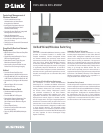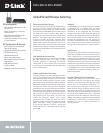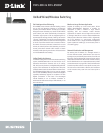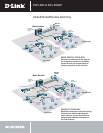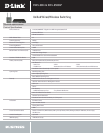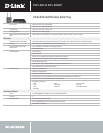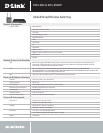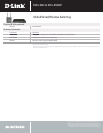
Self-Healing and Load Balancing
D-Link DWS series switches offer Self-healing process
and an AP load balancing features to increase the
resiliency of a wireless network. To make up for a sudden
RF signal vacuum created by any “dead” AP (AP with DC
power failure), the switch automatically increases the
transmitter output power of all the neighboring APs to
expand their RF coverage, thereby “healing” the network
“wound”. “Self-healing” can also be accomplished with a
redundant switch, which can take over the management
of the AP if and when the AP loses connection with the
first switch. To ensure continuous connection for current
clients, the switch performs load balancing across the
access points when network traffic reaches a certain
threshold, while rejecting new client-to-AP associations
to avoid bandwidth overcrowding.
Unified Switch Architecture
In addition to being the core unit of the wireless switching
system, the DWS-3024 switch can also function as an
advanced wired device. Features such as IP routing,
ACL, QoS, security features, and Gigabit/10-Gigabit fiber
support, allow businesses to integrate their enterprise
wireless networks with the wired network infrastructure.
The DWS-3024 Unified Switch can be used to upgrade
their current 10/100Mbps desktop connections to Gigabit
capability. Seamlessly upgrade to an 802.11n AP with
Gigabit connections in the future. The advantages
include flexibility to act as wireless controllers or
dedicated full-featured multi-layer LAN switches, or as
dual-role devices.
Medium to Large Business Application
Capable of handling up to 48 access points, D-Link
Unified Wired/Wireless Switching is suitable for
deployment in either a medium or large network
supporting VoIP and numerous mobile wireless
applications. A network site can begin with one switch
to manage a few APs or to use for mixed wired/wireless
LAN purposes. When the number of APs is augmented,
up to four switches in a peer-to-peer configuration
can be added to form a large centralized management
system capable of handling up to 192 access points in
one roaming group.
Network Visualization and Management
By entering the IP address of a managed switch or
into the Internet browser, administrators can view the
topological map and identify the locations of the AP and
the switch. The map displays AP icons and colors used to
differentiate between the different RF channels used by
the AP. Administrators can create individual user profiles
and be informed of any rogue APs. Users’ authentication
is based on profiles and not on any specific access point.
As users move around within a network, their movement
can be traced as they roam from one access point to
another.
Unified Wired/Wireless Switching
DWS-3024 & DWL-8500AP



